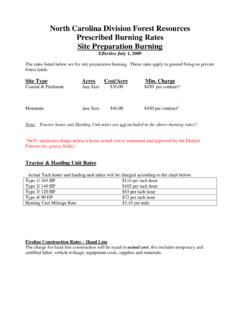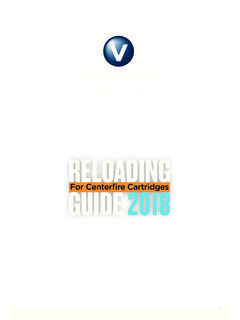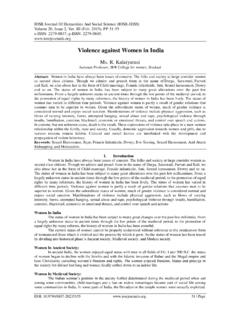Transcription of Heat Release Rates of Burning Items in Fires
1 (c)2000 American Institute of Aeronautics & Astronautics or published with permission of author(s) and/or author(s) sponsoring organization. A004 6576 AIAA 2000-0722 heat Release Rates OF Burning Items IN Fires HYEONG-JIN KIM and DAVID G. LILLEY Lilley & Associates Route 1 Box 151 Stillwater, OK 74074 38th Aerospace Sciences Meeting & Exhibit lo-13 January 2000 / Reno, NV For permission to copy or republish, contact the American Institute of Aeronautics and Astronautics 1801 Alexander Bell Drive, Suite 500, Reston, VA 20191 (c)2000 American Institute of Aeronautics & Astronautics or published with permission of author(s) and/or author(s) sponsoring organization.
2 HEATRELEASERATESOF Burning Items IN Fires HyeongJin Kim* and David G. Lilley** Lilley & Associates Route 1 Box 151 Stillwater, OK 74074 ABSTRACT heat Release Rates of typical Items in Fires are needed as a prerequisite for estimating fire growth and temperatures in structural Fires . That is, these Burning Rates are required to be specified by the user as input to single-room and multi-room structural fire computer codes like FPETool, FASTLite and HAZARD. Data are given here that permit Burning Items to be specified in a useful modeled way, taking a t*-fire for the growth and decay periods, with a constant maximum heat Release rate between these two periods.
3 INTRODUCTION Computer codes are available that permit calculations to be made of the effect of a given specified fire on the subsequent environment in a structural fire. Things like temperature of the smoke layer, its depth from the ceiling downwards, its optical density, ceiling, wall and floor temperatures, floor surface heat flux rate, etc are calculated a a function of time in all the rooms of a typical multi-room structural fire. However, the accuracy of these calculations is strongly dependent upon the correctness of the initial fire specifications. heat Release Rates of typical Items in tires are needed as a prerequisite for estimating fire growth and temperatures in structural tires.
4 That is, these Burning Rates are required to be specified by the user as input to single- room and multi-room structural tire computer codes like FPETool, FASTLite and HAZARD, see Bukowski et al (1989), Peacock et al (1994), and Portier et al (1996). Data are given here that permit Burning Items to be specified in a useful modeled way, taking a t2-fire for the growth and decay periods, with a constant maximum heat Release rate between these two periods. A vast range of many Items are considered. Detailed tabulation and graphic display of the parameters (for each item during experimental bums) permits fire modelers to initiate calculations.
5 Further knowledge enables the deduction of when second and subsequent Items may become involved, whether flashover may occur, and when conditions may become untenable. Thus, it is clear that many important phenomena that are calculated in Fires depend on the quality and accuracy of the initial bum specification. FUNDAMENTALS Typically, the heat Release rate ( heat energy evolving on a per unit time basis) of a fire 0 (kW) changes as the size of the fire changes, as a function of time t (seconds) after fire ignition. That is, the variation of G versus t is extremely important in characterizing the rate of growth of a fire.
6 Data are available for heat Release rate vs. time for many Items , see for example Babrauskas and Grayson (1992), SFPE (1995) and the data base in Bukowski et al. (1989). Furniture calorimeter and cone calorimeter measurements are available, with data specifically for: Pools, liquid or plastic Cribs (regular array of sticks) Wood pallets Upholstered furniture Mattresses Pillows Wardrobes (closets) Television sets Christmas trees * Member AIAA ** Professor, Fellow AIAA Copyright 1999 by D. G. Lilley. All rights reserved Published by AIAA with permission. (c)2000 American Institute of Aeronautics & Astronautics or published with permission of author(s) and/or author(s) sponsoring organization.
7 Curtains (drapes) Electric cable trays Trash bags and containers Industrial rack-stored commodities Notice that although data may well be available from careful laboratory experiments, the data may not apply directly to real-world fire situations. The laboratory data does not usually take into account the enhancement of Burning Rates because of radiation feedback. Full-scale timiture calorimeter tests give useful information on the Burning Rates of many typical household Items . Peak heating values are particularly useful to know, since in some cases a triangular heat Release rate vs.
8 time representation can be utilized for simplicity. Upholstered furniture - wood frame, with fire- retardant polyurethane padding and olefin cover fabric - show peak heat Release Rates as follows: F21 Chair 2100 kW at 260 s F3 1 Loveseat 2886 kW at 230 s F32 Sofa 3120 kW at 215 s The F number used here corresponds to the particular experiment performed, see Bukowski (1989). Other useful peak heat Release Rates : Mattress and boxspring 660 kW at 910 s Curtain, cotton, kg 240 kW at 175 s Wastepaper basket, kg 15kW at 350 s Television, kg 290 kW at 670 s Cooking oil, corn, cottonseed, etc.
9 12-inch pan Christmas tree, spruce, 7 kg 116kW constant 650 kW at 350 s and the values help to visualize the differences between the Items under Burning conditions. Of special concern in fire investigation and computer reconstruction of building Fires is the use of accelerants. Liquid fuels are often preferred. They are used to accelerate the development of the fire, as indicated by temperature and spreading Rates . On the practical investigative side, features often include: low bums, high temperatures at low hidden locations, rapid house fire development, and particular flame and smoke colors seen by witnesses.
10 Burning Rates of liquid pool Fires are available in SFPE (1995): POOL Fires The thermal radiation hazards from hydrocarbon spill Fires depend on a number of parameters, including the composition of the hydrocarbon, the size and shape of the fire, the duration of the fire, its proximity to the object at risk, and the thermal characteristics of the object exposed to the fire. The state of the art of predicting the thermal environment of hydrocarbon spill Fires consists essentially of semiempirical methods, some of which are based on experimental data from small- and medium-scale tests.






